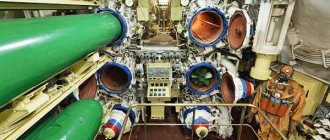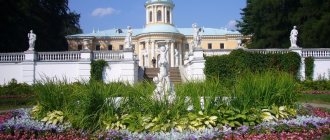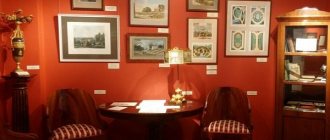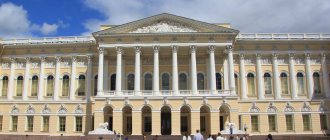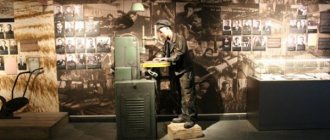Art of Ancient Egypt
Most of the objects on display have been on display since the opening of the Museum of Fine Arts in 1912 and form the core of one of the world's finest private collections of ancient Egyptian art. We are talking about the Russian orientalist Vladimir Semenovich Golenishchev (1856 - 1947). His collection, numbering approx. 8 thousand items, became the first museum acquisition of originals in 1909. In 1913, the museum bought a collection of monuments from the major Moscow collector L.I. Ginzburg, including a relief block depicting mourners. Several truly precious gifts were brought to the museum by Yu.S. Nechaev-Maltsov: these are excellent Fayum portraits, a golden diadem and a statue of Harpocrates. After the October Revolution, the Egyptian collection was replenished with exhibits transferred from various museums and private collections. The Egyptian monuments they owned were donated to the Department of Ancient Orientation by scientists whose activities were inextricably linked with the museum - B.V. Farmakovsky, T.N. Borozdina-Kozmina, A.V. Zhivago. The museum's collection was significantly enriched after the acquisition in 1940 from N.A. Prahov of the collection of his father, philologist and art critic A.V. Prahov, numbering 217 exhibits. In subsequent years, the collection was replenished through donations, archaeological excavations, and periodic purchases.
The first exhibition of the hall of Ancient Egypt, timed to coincide with the opening of the Museum of Fine Arts, was made by the outstanding Russian Egyptologist Boris Aleksandrovich Turaev (1868 - 1920), the second, post-war, by Professor Vsevolod Vladimirovich Pavlov (1899 - 1972). The present exhibition opened in 1969. Its inspirer and organizer was the head of the Department of Ancient Orient, Doctor of Art History Svetlana Izmailovna Khodzhash (1923 – 2008).
The monuments in the hall are arranged in chronological order, starting with the most ancient - stone tools of the 6th - 5th millennium BC. (?), slate pallets and painted clay vessels of the Nagada I – III culture (IV millennium BC). The various forms of ceramic products and the presence of paintings give an idea of the high level of development of the artistic craft of this era. A rare exhibit is a clay dish depicting a masked hunter holding four dogs on a leash. All objects were found in burials and are evidence of ritual practices of the Predynastic period. Already at this time, the main features of ancient Egyptian art appeared: conditioned by religious ideas, convention, symbolism, monumentality, which were fully developed after the unification of Upper and Lower Egypt into a single state (late 4th millennium BC) - during the Ancient Kingdom (XXVIII–XXIII centuries BC).
The Ancient Kingdom is the time of the first flowering of Egyptian architecture, the final design of the pictorial canon, which Egyptian masters would adhere to for several millennia. During the same period, one of the greatest achievements of art appeared - the sculptural portrait. The principles of decorating tombs with wall relief images, as well as the peculiarities of rendering the human figure and objects on a plane, are illustrated by a series of blocks from the tombs of the “chief of the royal treasury” Isi, the Egyptian Merit, the Egyptian Tepemankh (all - ca. 25th century BC), “ gardener of the pyramid of King Pepi II" Hiiu (c. 23rd century BC)
The visual creativity of the ancient Egyptians was inextricably linked with religious beliefs and the requirements of the funeral cult. In particular, the portrait resemblance of the image to the person being portrayed was due to the belief that every person has a “double”, or “Ka” - a certain vital essence, which, being immortal, must have a permanent home in some image of the deceased. The idea that all monuments were intended for eternity and should not contain anything accidental or fleeting determined the features of the conventional artistic language of Egyptian plastic art: closedness and undifferentiated volume, static nature, lack of excessive detail. Reliefs and statues of the V-VI dynasty (showcase No. 6) and a separate sculptural group of the official Uja-dzher with his wife are clear examples of the embodiment of the canonical rules of depicting a person in sculptural images.
Showcase 6 contains individual objects that were placed in the tomb, and a unique exhibit - the mask of Pepi II (XXII century BC, VI dynasty), brought by V.S. Golenishchev from excavations at the site of the pyramid of this king.
The Middle Kingdom (XXII–XVIII centuries BC) is represented by such masterpieces as the portrait of King Amenemhet III (XIX centuries BC) and the stele of the “great steward” Khenenu (XXI–XX centuries BC .) from pinkish limestone.
The upper part of the statue of Amenemhat III brilliantly illustrates the best features of the sculptural portrait of the Middle Kingdom during its heyday - interest in the individual and age characteristics of a person. The viewer can also see small examples of sculptural works (window No. 9), including a portrait of King Senusret II.
Two showcases display objects from the tombs of the Middle Kingdom that were necessary for the deceased in the afterlife - wooden models of funeral barges and figurines of servants (display case No. 10), as well as “magic wands”, magical female figurines, palettes in the shape of animals, small vessels made of stone (showcase no. 9).
The art of the New Kingdom (XVI-XI centuries BC) bears the imprint of the triumph of the Egyptian state after the expulsion of the Hyksos from the country.
The art of this extended period is characterized, on the one hand, by the strengthening of realistic tendencies, interest in depicting nature, the desire to convey movement, and on the other hand, by an increase in decorativeness, refinement and at the same time the formalization of artistic language. These qualities are clearly visible in monuments from the reigns of pharaohs Amenhotep III and Amenhotep IV (XIV century BC): in faience vessels and inlays on walls and furniture from Amarna, cosmetic spoons, playing chips, small figurines, as well as in a portrait of a young man from limestone. One of the masterpieces of the collection is distinguished by its exquisite beauty - a cosmetic spoon in the shape of a pink lotus flower, with a handle in the shape of a swimming girl. An excellent quality wooden spoon in the shape of a girl among thickets of papyrus, a wooden oval box with a retractable lid inlaid with earthenware inserts are wonderful examples of the art of ancient Egyptian woodcarving masters.
The undisputed masterpiece of the Egyptian collection of the Pushkin Museum is the paired sculptural group of the priest Amenhotep and his wife priestess Rannai, dating back to the reign of Hatshepsut. The figurines are made of rare ebony, imported to Egypt from the southern regions of Africa; the eyes of the spouses are inlaid with glassy paste. Slender figures, thin limbs, the presence of exquisite details - gilded jewelry and a luxurious women's wig - bring to us all the unique and recognizable beauty of the best works of ancient Egyptian art.
Showcase No. 14 displays a relief from a private tomb from the late 18th century. in Saqqara depicting mourning for the deceased. The dynamic composition and the depiction of human figures from complex angles give this fragment of the funeral procession drama and expressiveness.
The funeral rite, which played a huge role in the religion of the Egyptians, gave rise to a variety of objects directly related to the funeral cult and ideas about the fate of the deceased after death. These are sarcophagi, canopic jars (vessels for storing the embalmed entrails of the deceased), funeral masks, ushabti figurines and boxes for their storage, figurines of gods. In one of the display cases there is a swaddled mummy of the priest Khor-kha, covered with a net of faience beads, and the head of a woman’s mummy, as well as mummies of sacred animals - a cat and a falcon. Nearby, on the podium, is a set of canopic jars with lids in the form of the heads of the sons of the god Horus. The sarcophagi that are exhibited in the hall belong to different eras, starting from the 3rd millennium BC. (a simple clay box with a relief image of a boy in a fetal position on the lid). The brightest sarcophagi, completely covered with paintings, date back to the New Kingdom and are exhibited in the central part of the hall. Two stone sarcophagi date back to the second half of the 1st millennium BC.
Several display cases display numerous gods of the Egyptian pantheon. They are made of bronze, stone (statues of Osiris in showcases No. 24 and No. 26), small figurines of gods made of carnelian and rock crystal (display case No. 12). The figurine of the god of vegetation Nefertum is cast from silver (display case No. 18), and the sacred ibis of the god Thoth (display case No. 12) is made of white stone, with a bronze head and paws. All figurines are distinguished by high quality casting and fine detail work.
A significant part of the monuments consists of alabaster vessels, faience bowls, painted clay jugs, bronze situlas (ritual vessels) and mirrors, bronze weapons, jewelry made of semi-precious stones and Egyptian faience.
The Late Period (1st millennium BC) includes statues and sculptural portraits (display case No. 26). Among them, a granite statue of the queen stands out, whose face has pronounced portrait features (first half of the 7th century BC). Made of solid stone, portraits from the period of the Sais dynasty (second half of the 7th–6th centuries BC) imitate ancient examples and reveal the craftsmen’s desire for perfection of form and ideal processing of the stone surface. The Sais period was a time of new flowering of artistic craft.
The so-called “sculptor's corner” allows you to get an idea of the process of creating reliefs and sculptural works by Egyptian masters: here you can see unfinished reliefs or copies made by students, as well as drawings on pieces of limestone (ostraca).
Exhibition - for the first time
“Many museums around the world examine their mummies—the Louvre, the British Museum, the New Museum in Berlin—but never before have this work resulted in an exhibition. We plan to create an impressive exhibition in 2021 that will connect art and science. This is an opportunity for all of us to create that imaginary world absolutely clearly,” said the agency’s interlocutor.
In order for this to happen, scientists have been working with mummies from the Pushkin Museum for several months. In particular, chemical analysis, CT and MRI were done. The interim results, Loshak said, demonstrate “an impressive and very clear result.” For example, 3D models of the body and skull have already been created, as well as a model of the skull from a special material.
“We know about each of our heroes the history of his illness, that is, we know more about the world that surrounded them. Now anthropologists and geneticists must step in to recreate this picture absolutely accurately at their level. So, layer by layer, work is underway, which opens up more and more new possibilities for understanding the world of the past, so far from us,” shared the director of the Pushkin Museum.
According to her, it is now premature to talk about the timing of the completion of the research, since it depends on discoveries that will still be made during the work.
“The most important thing is that the course will continue. Under our curatorial control, we hope, scientists will examine all the mummies that are in our regional museums, and there are quite a lot of them,” Loshak concluded.
Pushkin Museum: ticket price and opening hours
The opening hours of the Pushkin Museum depend on the day of the week:
- Tuesday, Wednesday, Saturday and Sunday : from 11:00 to 20:00. The ticket office closes at 19:00.
- Thursday and Friday : from 11:00 to 21:00. The ticket office closes at 20:00.
Mondays are closed at the Pushkin Museum.
Opening hours of branches and divisions of the Pushkin Museum
The cost of a ticket to the Pushkin Museum depends on the exhibitions visited:
- Permanent exhibition in the Main Building of the museum or visit to the Gallery of European and American Art (your choice): 400 rubles - adult ticket; 200 rubles - ticket for preferential categories of citizens; for children under 16 years old - free.
- The combined ticket is temporarily not available. For current information, see the office. website. Ticket for 2 exhibitions - to the Main Building and the Gallery of European and American Art: 600 rubles - adult ticket; 300 rubles - ticket for preferential categories of citizens; for children under 16 years old - free.
Preferential categories of citizens include: visitors under 18 years of age; full-time students of Russian universities; Russian pensioners and members of large families; holders of international ISIC cards; members of the Union of Designers and Architects of the Russian Federation.
Members of large families can visit the museum for free every Tuesday and the first Sunday of the month.
© State Museum of Fine Arts named after A. S. Pushkin
Admission to temporary exhibitions is usually included in the standard admission price. But for some exhibitions you need to purchase a separate ticket. Information can be clarified before visiting on the official website of the Pushkin Museum.
Museum collections
The collections of the Pushkin Museum are divided into 9 groups by genre:
- Masterpieces. The group of masterpieces of the Pushkin Museum includes outstanding paintings by Russian (Serov, Vrubel) and foreign artists (Matisse, Rembrandt), sculptures of ancient times and the Renaissance (Michelangelo Buanarrotti)
- Graphic arts. The collection of graphics includes almost 400 thousand exhibits, including: woodcuts by Japanese authors, medieval engravings, drawings by Vrubel, Dali and many other artists.
- Painting. The number of paintings in the museum reaches 4,900 exhibits: from Byzantine icons and mosaics to masterpieces by Kandinsky, European Fauvists and Impressionists.
- Sculpture. More than 6,000 exhibits represent the widest collection of sculpture from different times: from ancient Egyptian statues to Rodin and Bourdelle.
- Archeology. The archaeological department houses more than 8 thousand exhibits from Assyria, Ancient Greece, Ancient Rome and Egypt.
- Applied arts. Household items of different nations and their applied art make up 22 thousand exhibits. Among them: furniture, embroidery, glassware and porcelain from different eras.
- Collection of casts of the Tsvetaevs. The collection is only partially exhibited in the Pushkin Museum; most of it is in the Educational Museum named after I.V. Tsvetaev. The collection includes casts of world masterpieces - from statues to portraits.
- Numismatics. The numismatics collection is one of the largest in the museum - 175 thousand exhibits.
- Documents and photographs. The museum houses 1,700 photographs and negatives from different times, as well as 229 important historical documents.
© State Museum of Fine Arts named after A. S. Pushkin
Virtual tour of the Pushkin Museum

